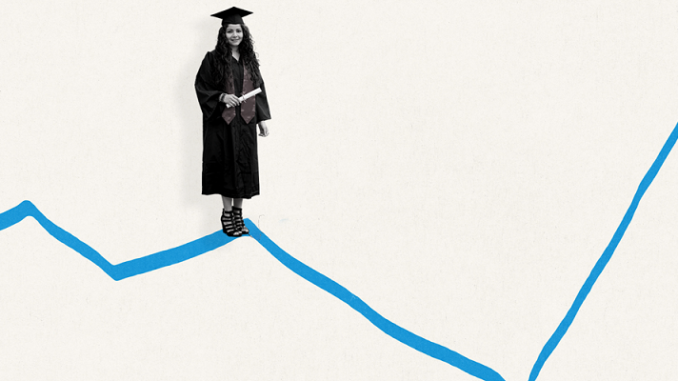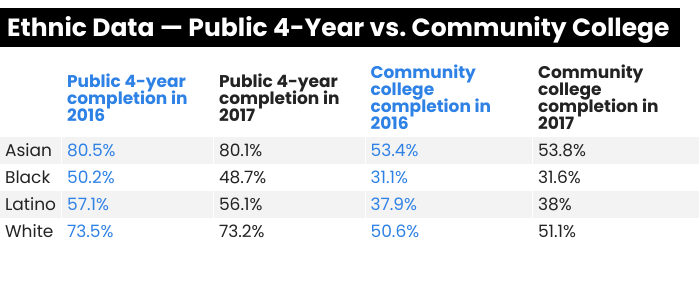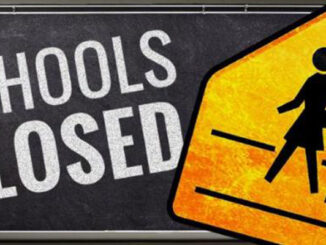
New report shows stalled college completion rates with disparate declines for Black and Latino students at public four-year colleges.
By Joshua Bay, The74
This article originally appeared on The74
As pandemic challenges changed Black and Latino students’ view on the value of a college education, their four-year completion rate declined — but grew at two-year community colleges, a new report found.
While overall completion rates for students nationwide stalled at all colleges, Black and Latino students’ saw success at community colleges, which were prepared for pandemic challenges with tools in place like online classes for working students.
“[Community colleges] were better situated to handle the disruption from in-person to online courses…and that, in fact, led to greater retention rates,” said Josh Wyner, founder and executive director of the Aspen Institute College Excellence Program.
Analyzing trends for students six years after enrolling in postsecondary education, a new report from the National Student Clearinghouse Research Center found a 62.2 percent completion rate for those starting in fall 2017 — a stalled number compared to 2015.
But, Black and Latino students’ who enrolled in fall 2017 saw completion rates decline to 43.4 percent and 50.1 percent respectively — a 0.5 and 0.2 percentage point drop compared to those enrolled in 2016.

Wyner said the imbalance for Black and Latino students came from either the need to work when parents lost their jobs or the need to take care of siblings because their parents didn’t have jobs during the pandemic where they could work from home.
“Income and wealth disparities often prevented students from these groups from not only enrolling in college in the first place but also staying when there were disruptions,” Wyner said.
At public four-year colleges, Black and Latino students saw steeper completion rate declines to 48.7 percent and 56.1 percent respectively — a 1.5 and 1 percentage point drop compared to those enrolled in 2016.
In contrast, Black and Latino students at community colleges increased to 31.6 percent and 38 percent respectively — a 0.5 and 0.1 percentage point gain compared to those enrolled in 2016.

Wyner said the completion rate hike at community colleges was because those schools historically enroll students with diverse educational needs, and by necessity, were already invested in online learning pre-pandemic.
Amrit Ahluwalia, director of strategic insights at Modern Campus, said in a statement in response to the report that the increase in community college completion rates show how young students view college as a “means to an end.”
“When they get the learning they feel they need to support their short-term employability, they find jobs and leave their programs,” Ahluwalia said.
Wyner said because Black and Latino students often come from lower income communities, they view community college as a more attainable means of education.
“On average, tuition for a public institution is twice the rate at a four-year college than a community college,” Wyner said. “So it would make sense that if income correlates [completion declines for Black and Latino students] would be felt more in the four-year space than the community college space.”
This comes as more than 2.4 million students enrolled in postsecondary education for the first time in fall 2017 — an increase of 1.2 percent compared to 2016.
“Not only have fewer of the 2017 starters completed as of 2023, but the data also show fewer still enrolled, suggesting that this is more than just a matter of slower progress during the pandemic years,” Doug Shapiro, executive director of the research center, said in a statement.
In addition, the gender gap continued to grow for those enrolled in fall 2017 — with a completion rate of 65.6 percent for female students compared to 58.4 percent for males.

Wyner said the low number of colleges providing hands-on learning had a disproportionate impact on male student retention.
“There’s pretty good evidence that adults learn better when theory is taught alongside hands-on learning,” Wyner said. “I do think that is something that really needs to be thought about as a way to bring men back into higher ed.”
He added how this is especially true for male students who feel disconnected from learning because they were raised in families that worked blue-collar jobs without needing a degree.
Moving forward, Wyner said colleges need to fully address the value they offer to students so they continue to stick around despite their life circumstances.
“If your programs aren’t actually delivering value to students, they may be making entirely rational decisions to leave,” Wyner said.
.
Joshua Bay is a staff reporter at The 74.



